The Backyard Livestock and Poultry Surveys (BLPS) and the Commercial Livestock and Poultry Surveys (CLPS) are two (2) major surveys which aim to determine and measure the performance of the livestock such as inventory, supply, disposition and commercial farms, volume of production and other related data of farm animals from the backyard (small hold raisers) and commercial livestock and poultry industry.
A. Inventory of Livestock and Poultry
1. Inventory of Livestock in Province of Cebu in 2023
The beginning inventory of the total population livestock in 2023 recorded at 1,097,445 heads. This was 5.24% higher than the previous year’s beginning inventory or an increase of 54,679 heads. In 2022 the same period, total population livestock posted at 1,042,766 heads. (Figure 1)
Figure 1: Total Population of Livestock Animals in the Province of Cebu
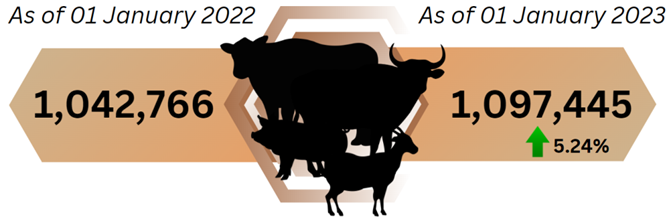
Source: Philippine Statistics Authority
For the year 2023, all kinds of livestock in Province of Cebu increased during the first period (as of January 1, 2023) compared to the same period in the previous year. Swine has the highest total inventory of livestock with increased of 2.64% from 562,573 heads to 577,448 heads. This was followed by Goat with increased of 10.58% from 167,056 heads in January 1, 2022 to 184,727 heads in the same period in 2023.Carabao has the highest rate increased in inventory with 12.13% from 65,053 heads to 72,943 heads. On the other hand, Goat has the least increased with 5.74% from 248,084 heads to 262,327 heads. (Figure 2)
Figure 2: Inventory of Livestock by Animal Type in the Province of Cebu
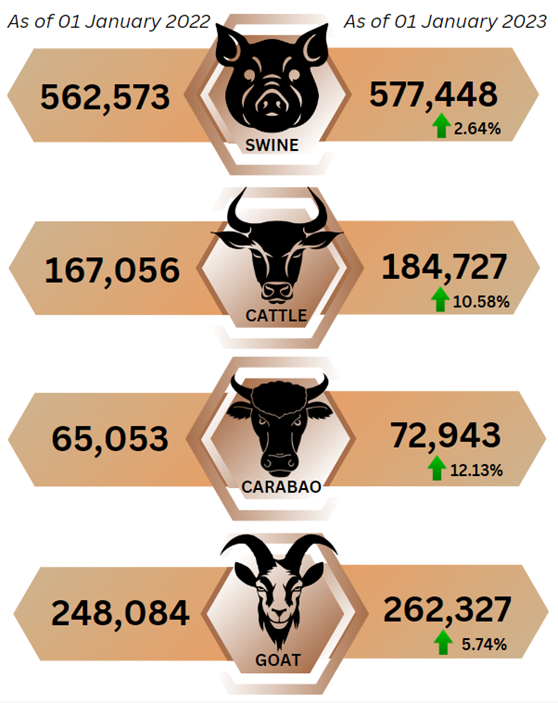
Source: Philippine Statistics Authority
2. Chicken and Poultry Inventory by Animal Type
In 2023, the beginning chicken inventory decreased by 1.47% with 11,536,382 birds compared to the previous year’s same period at 11,708,614 birds. (Figure 3)
Broiler chicken had the largest population in the beginning inventory of 2023 at 4,711,333 birds. This was recorded a decline with 7.28% or a decrease of 370,132 birds. This was followed by Layer chicken with 7.12% decline rate from 3,738,606 birds (as of January 1, 2022) to 3,472,522 birds in the same period of 2023. On the other hand, Native/Improved chicken had the least population recorded among the three animal types of chicken with 3,352,527 birds in the beginning inventory of 2023. It also had a significant increase of 16.06% from 2,888,543 birds of the same period in previous year. (Figure 3)
Figure 3: Distribution of Chicken Inventory by Animal Type in the Province of Cebu
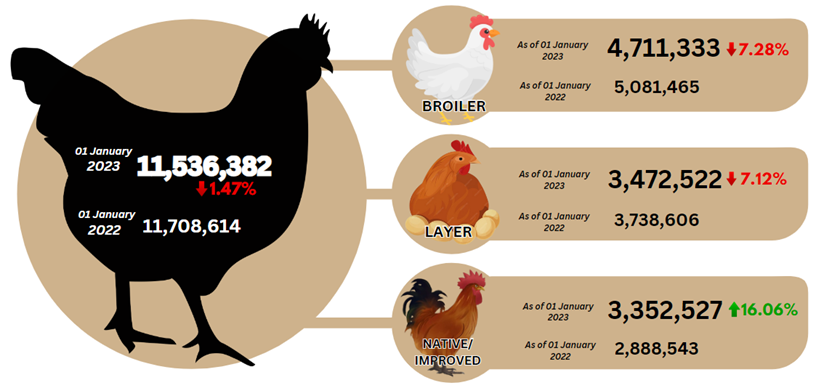
Source: Philippine Statistics Authority
B. Volume Production of Livestock and Poultry
1. Livestock: Volume of Production by Animal Type in Province of Cebu
In terms of volume production in livestock sector, Hog production contributed the most with 138,886.58 metric tons during the year. It showed a growth rate of 10.23% from 126,000.68 metric tons in 2022. This was followed by the slight decreases of Cattle at 2.14% from 9,531.27 metric tons to 9,327.23 metric tons, and Goat at 7.82% from 5,717.55 metric tons to 5,270.55 metric tons. On the other hand, Carabao had the least production recorded with 33.43% growth rate from 2,238.81 metric tons in 2023 to 2,987.19 metric tons during the year. (Figure 4)
Figure 4: Volume Production of Livestock Animals (MT) in the Province of Cebu, 2023
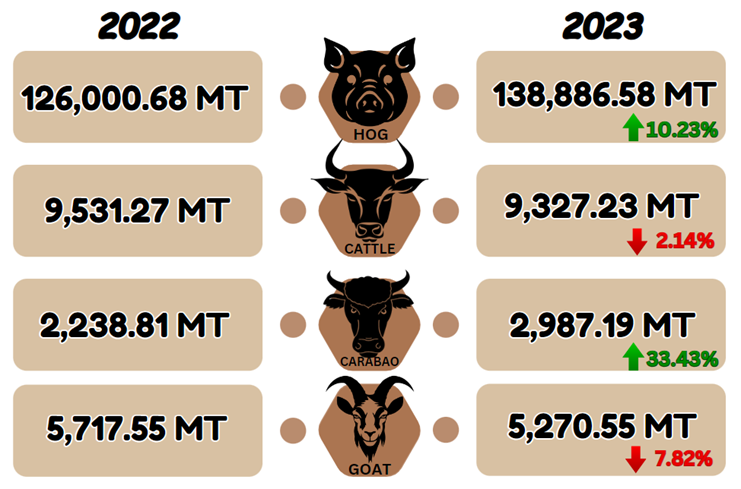
Source: Philippine Statistics Authority
2. Poultry: Volume of Production by Commodity
Figure 5: Volume Production of Poultry (MT) in the
Province of Cebu
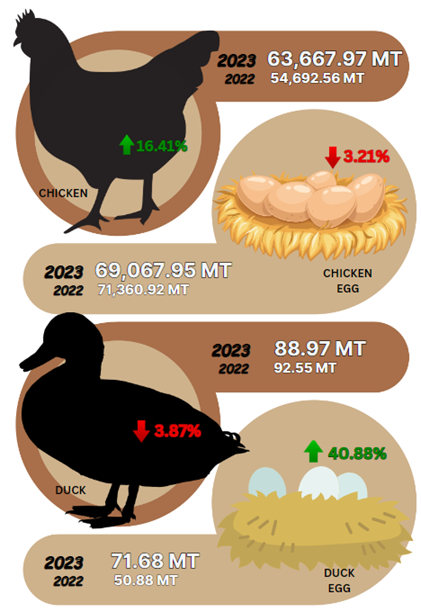
Source: Philippine Statistics Authority
In the province’s poultry sector, in terms of volume of production, Chicken recorded at 63,667.97 metric tons in 2023. It had a significant increase of 16.41% from the previous year’s production while its egg posted with 3.21% decline from 71,360.92 metric tons in 2022 to 69,067.95 metric tons during the year. On the contrary, Duck showed a slight decrease of 3.87% with 88.97 metric tons in 2023 while its egg had a high growth rate of 40.88% from 50.88 metric tons in 2022 to 71.68 metric tons during the year.
TECHNICAL NOTES
Livestock – refers to farm animals kept or raised for consumption, work or leisure. In general, poultry is separated as a distinct group of farm animals. For purposes of censuses and surveys, livestock covers only those that are tended and raised by an operator.
Livestock/Poultry Production – refers to the volume of indigenous (locally-raised) animals disposed for slaughter plus animals exported or shipped-out for slaughter both in live weight equivalent.
Poultry – a collective term for all domesticated avian for the purpose of food consumption or, the carcass of such avian dressed/processed for human consumption. Fowl is a term used to refer to a specific group of avian sharing common anatomical characteristics, e.g., chicken and duck.
Inventory - actual number of animals (in head/bird) present in the farm as of a specific reference date regardless of ownership
Carabao - is a domestic swamp-type water buffalo native to the Philippines.
Cattle – is a large ruminant animal with horns and cloven hoofs, herbivores, domesticated for meat or milk, or as beasts of burden.
Goat – is a hardy domesticated ruminant animal that has backward curving horns, (in the male) a beard, and, domesticated for milk and meat.
Swine – a non-ruminant, cloven-footed animal belonging to family suidae with simple stomach, having a snout, large number of mammary glands, thin skin, and heavy bristles.
Approved by:
MELCHOR B. BAUTISTA
Chief Statistical Specialist
FFES/MJDG

